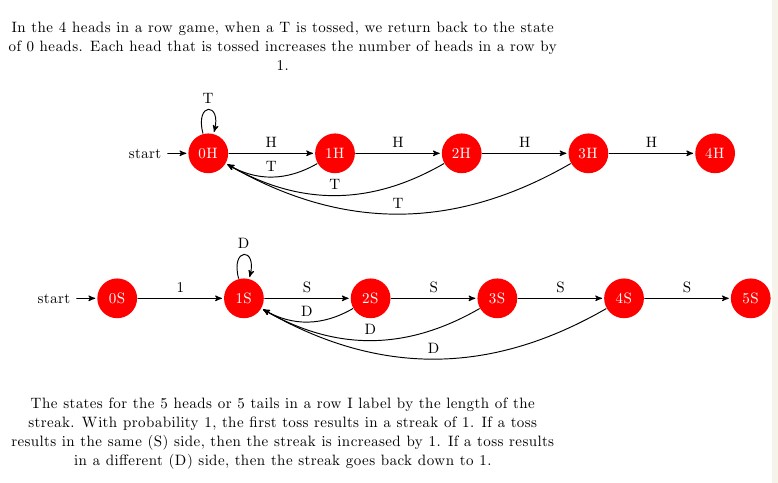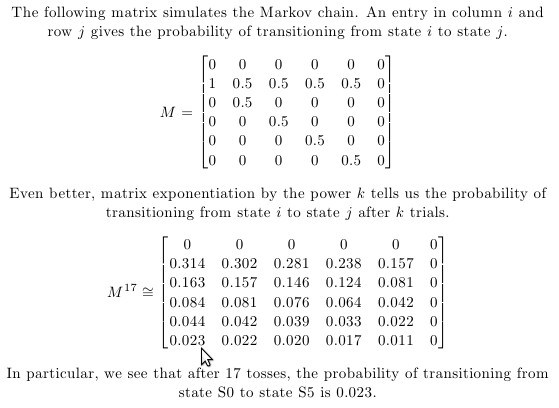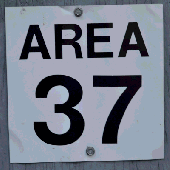-
 Mon 7th Oct 2013 13:41 #41 / 62
Card Membership - putting the power of factories in your hand.
Mon 7th Oct 2013 13:41 #41 / 62
Card Membership - putting the power of factories in your hand.Interestingly, the older the student (or adult), the more likely they will choose C, D, or F. 4th Graders are more likely to choose B, and almost no one thinks it will happen by the 16th flip. As you all know, there are many conceptual fallacies involving probabilities and they are widely held in populations.
-
 Mon 7th Oct 2013 13:51 #42 / 62
Card Membership - putting the power of factories in your hand.
Mon 7th Oct 2013 13:51 #42 / 62
Card Membership - putting the power of factories in your hand.Hugh wrote:
I use p(n) to mean the probability of getting the first 5 in a row after n flips. In his notation, n is an arbitrary number of heads to get in a row. So, when n = 3, he's talking about a game where the goal is to hit 3 heads in a row. When he writes p_n(M = 2n+1), this is the probability of hitting n heads in row for the first time on the (2n+1)-st coin toss. For n = 3, this is the probability of hitting 3 heads in a row for the first time on the 7th toss. I would have just written p(7), if that was the specific game we were playing. Keep in mind that he is investigating the situation for arbitrary n.
I interpreted this correctly - both for you and the author.
The reason our recursions don't match is because he didn't give you a recursion!! He gives you something to work out the first few results, up to 2n+1, and then he clearly gives up. The reason is that his goal was a formula FOR ALL n.
Yes, so you understand why I was frustrated when he gives the formula for p(11) ..or pn(M = 2n+1), and doesn't follow for p(12), leaving my to my own devices.
If he had known that the goal was just to get a recursion for n = 4, he could have gotten one, because he has a Markov chain, and from a Markov chain, you can get a recursion. He had a way to generate the data, because he has graphs of the probability distributions.
If he could generate the graphs, he should know (and include) the equation for deriving p(n), right?
There are ways we can check my recursion. We could look at the Markov chain in matrix form. Also, a brute force program to traverse the probability tree would verify or falsify the result. If my recursion is wrong, fear not, for there IS a correct recursion. We have a Markov chain - it can be done.
I would love to see this..
Edited Mon 7th Oct 13:53 [history]
-
 Mon 7th Oct 2013 14:24 #43 / 62
Card Membership - putting the power of factories in your hand.
Mon 7th Oct 2013 14:24 #43 / 62
Card Membership - putting the power of factories in your hand.Hugh wrote:
Before you catch this typo I made, 30/1024 ~ 0.02929 = 2.929%. The point is that your chart doesn't match this for p(10).
The author states that "from M =n + 1 through M = 2n flips, the probability is constant, pn(M ) = pn+1." I interpret this to mean (1/2)^6, which doubled gives us 1/64 (*2 to account for H and T) = 3.125% from p(6) through p(10).
At some point, I'll do the Markov chain simulation and post results.
:)
Edited Mon 7th Oct 14:25 [history]
-
 Mon 7th Oct 2013 15:21 #44 / 62
Mon 7th Oct 2013 15:21 #44 / 62
M57 wrote: At this point, it's nothing more than a personal quest.
And is keeping the boards interesting. Thank you.
-
 Mon 7th Oct 2013 15:40 #45 / 62
Card Membership - putting the power of factories in your hand.
Mon 7th Oct 2013 15:40 #45 / 62
Card Membership - putting the power of factories in your hand.Cramchakle wrote:
This would be one bit easier if we changed the question to only include getting 5 H in a row and not 5 H or 5 T.
Given that if the probability of 5H in a row is p, the probability for flipping 5T is also p. But are we not in agreement that flipping 5H OR 5T is 2p?
If the probability of 5H on p(6) is 1/32 (i.e., THHHHH), and the probability of 5H OR 5T is on p(6) is 1/16, then doesn't that suggest that 2p is the case moving forward in the series? ..or is it more complicated than that?
Edited Mon 7th Oct 15:40 [history]
-
 Mon 7th Oct 2013 18:11 #46 / 62
Mon 7th Oct 2013 18:11 #46 / 62
M57 wrote:
Given that if the probability of 5H in a row is p, the probability for flipping 5T is also p. But are we not in agreement that flipping 5H OR 5T is 2p?
No, we are not. A sequence like TTTTTHHHHH will be a winner according the the 5 H in a row game. And HHHHHTTTTT will be a winner in the 5 T in a row game. You add probabilities when you include all of the outcomes from both games. But in our game, we would have ended both of those sequences earlier. It should match 2p up to the point of 10 tosses.
What I have been saying is that your game is equivalent to making one arbitrary toss and then playing the 4 heads in a row game. So we can use any results of that paper, if you keep in mind this translation. The best way to see the translation is to draw the associated Markov chain. In the n-heads-in-a-row game the states are marked by how many heads you tossed in a row. In your game, the states are marked by how far along in a streak you are. The Markov chains are equivalent (except for the initial toss), though the winning outcomes look rather different on the surface.
Edited Mon 7th Oct 18:12 [history]
-
 Tue 8th Oct 2013 11:57 #47 / 62
Card Membership - putting the power of factories in your hand.
Tue 8th Oct 2013 11:57 #47 / 62
Card Membership - putting the power of factories in your hand.Using random.org I just completed 1,182 trials of 16 flips each, achieving 388 occurrences of either HHHHH or TTTTT, - and weighing in at 32.83%. I feel this is a large enough sample size that my calculation of 38.68% is highly questionable. Whereas, if I begin the recursion immediately at p(6), the expected result is 33.88% - much more in-line with expectations.
Tomorrow morning we'll play the game. One trial - Winners take all.
-
 Tue 8th Oct 2013 15:11 #48 / 62
Tue 8th Oct 2013 15:11 #48 / 62
Here is how I see the two Markov chains. The top is the 4 heads in a row game. The bottom is the 5 heads or 5 tails in a row game:

-
 Tue 8th Oct 2013 15:34 #49 / 62
Tue 8th Oct 2013 15:34 #49 / 62

-
 Tue 8th Oct 2013 19:52 #50 / 62
Card Membership - putting the power of factories in your hand.
Tue 8th Oct 2013 19:52 #50 / 62
Card Membership - putting the power of factories in your hand.I'm trying to understand your posts @Hugh. I understand the visual, and I can see how it has been turned into the matrix. I am reading up on matrices, but unfortunately, I can not find by simple search what matrix exponentiation is or how it works. E.g., I do not understand how the 0.314 value at (R2,C1) was derived from M17. My sense is that I should be able to determine that particular number easily enough, as it appears to be a "starting" place.
0.157 (R3,C2) appears to be 0.314/2 and columns 2 and 5 have shifted values, but I am struggling to find any consistent use of operations that yields the final numbers in the matrix. Could someone perhaps point me to a tutorial that could help me to understand this math?
-
 Tue 8th Oct 2013 22:18 #51 / 62
Tue 8th Oct 2013 22:18 #51 / 62
My guess is M is multiplied by itself 17 times. Never really dealt with matrix exponentiation is, but that's what it suggests to me.
-
 Tue 8th Oct 2013 22:25 #52 / 62
Tue 8th Oct 2013 22:25 #52 / 62
I found a place to run matlab online. Go here:
http://www.compileonline.com/execute_matlab_online.php
Delete the example script & Copy in this matlab script:
M = [ [0 0 0 0 0 0; 1 0.5 0.5 0.5 0.5 0; 0 0.5 0 0 0 0; 0 0 0.5 0 0 0; 0 0 0 0.5 0 0; 0 0 0 0 0.5 0]]
fprintf("M*M\n")
M*M
fprintf("M*...\n")
M*M*M*M*M*M*M*M*M*M*M*M*M*M*M*M*M
fprintf("M^17\n")
M^17Then click the 'execute' button.
Edited Tue 8th Oct 22:26 [history]
-
 Wed 9th Oct 2013 01:25 #53 / 62
Wed 9th Oct 2013 01:25 #53 / 62
As Ozyman suggested, I did mean M multiplied by itself 17 times. "Matrix exponentiation" turns out to be a bad keyword for a search due to other meanings. For Markov chains, the relevant terminology for the associated matrix is "the transition matrix of a Markov chain".
Here is a gentle-like introduction. Towards the end, the video talks about repeated multiplication and the relationship to a Markov chain. (Note that I'm using a slightly more general result than the video presenter.)
Edited Wed 9th Oct 01:26 [history]
-
 Wed 9th Oct 2013 13:49 #54 / 62
Card Membership - putting the power of factories in your hand.
Wed 9th Oct 2013 13:49 #54 / 62
Card Membership - putting the power of factories in your hand.@Hugh, Thanks! ..and just in time. I was able to run the script on the site for all values 5 - 52 and create a histograph for the expected probabilities in each range, which I showed to the assembly this morning right before we ran our single trial - and of course I was thrilled when the 5th consecutive head came up on the 13th toss. We had a lot of participation and the kids had fun rooting for their guesses.
A number of teachers told me that they ran a few trial runs with students when the subject was debated in classrooms and even on a bus coming home from an away game. Thanks all for helping. I'm always on the lookout for problems/games/brain-teasers that are appropriate for 4th - 8th graders (and faculty if possible) for which the correct or best answers are not easy to find on the internet. If it includes a little theater, all the better.Edited Wed 9th Oct 13:52 [history]
-
 Wed 9th Oct 2013 13:58 #55 / 62
Wed 9th Oct 2013 13:58 #55 / 62
Sounds awesome M57.
Kudos for giving a boost to Math education.
-
 Thu 10th Oct 2013 07:15 #56 / 62
Card Membership - putting the power of factories in your hand.
Thu 10th Oct 2013 07:15 #56 / 62
Card Membership - putting the power of factories in your hand.Ozyman wrote:
I found a place to run matlab online. Go here:
http://www.compileonline.com/execute_matlab_online.php
Delete the example script & Copy in this matlab script:
M = [ [0 0 0 0 0 0; 1 0.5 0.5 0.5 0.5 0; 0 0.5 0 0 0 0; 0 0 0.5 0 0 0; 0 0 0 0.5 0 0; 0 0 0 0 0.5 0]]
fprintf("M*M\n")
M*M
fprintf("M*...\n")
M*M*M*M*M*M*M*M*M*M*M*M*M*M*M*M*M
fprintf("M^17\n")
M^17Then click the 'execute' button.
@Ozy - I didn't realize you posted this -- Thank you as well.
So I was wondering, if we replace all occurrences of 0.5 with 0.16667 (and the 1 as well), would we get the answers for the same problem with six-sided dice?
Edited Thu 10th Oct 07:17 [history]
-
 Thu 10th Oct 2013 11:49 #57 / 62
Thu 10th Oct 2013 11:49 #57 / 62
M57 wrote:
@Ozy - I didn't realize you posted this -- Thank you as well.
So I was wondering, if we replace all occurrences of 0.5 with 0.16667 (and the 1 as well), would we get the answers for the same problem with six-sided dice?
I've been postponing coming back to this until the work week ends. I will probably also use the script to check values against the recursion if you haven't already, so it's very convenient that Ozyman posted that! (As you say, at this point it's just a personal quest. Pretty fun problem to think about!)
Cramchakle suggested that we could probably fit a nice continuous curve to these discrete distributions and then use integration to answer any question we want. I believe this can be done. My suspicion is that the distributions are approximately exponential decays of the form f(x) = Ke^-bx. The recursion, if correct, will have a closed form as the sum of a bunch of exponentials. Probably one of the exponentials dominates the others, so I think exponential decay will be a good approximation.
Regarding 6-sided dice: You will start a streak with probability 1, just as before. After that, the continuation of the streak is probability 0.166667, but starting the streak over when you miss occurs with probability 0.8333333. So, you'll have a bunch of 0.1666667's together with 0.833333's in the matrix. Same idea though.
Edited Thu 10th Oct 11:51 [history]
-
 Thu 10th Oct 2013 11:56 #58 / 62
Thu 10th Oct 2013 11:56 #58 / 62
Hugh wrote:
Cramchakle suggested that we could probably fit a nice continuous curve to these discrete distributions and then use integration to answer any question we want. I believe this can be done. My suspicion is that the distributions are approximately exponential decays of the form f(x) = Ke^-bx. The recursion, if correct, will have a closed form as the sum of a bunch of exponentials. Probably one of the exponentials dominates the others, so I think exponential decay will be a good approximation.
I wouldn't want to be on a rocket headed to Mars using the approximation this yields, but for the purposes we're working on here, I think it's useful.
-
 Thu 10th Oct 2013 17:29 #59 / 62
Fortune favors the bold, and chance favors the prepared mind...
Thu 10th Oct 2013 17:29 #59 / 62
Fortune favors the bold, and chance favors the prepared mind...Just out of curiosity M57, are you a math/science teacher or a student at this school?
-
 Thu 10th Oct 2013 19:00 #60 / 62
Card Membership - putting the power of factories in your hand.
Thu 10th Oct 2013 19:00 #60 / 62
Card Membership - putting the power of factories in your hand.itsnotatumor wrote:
Just out of curiosity M57, are you a math/science teacher or a student at this school?
Music / Math - Grade 5 / Public Speaking / and some technology support.
Originally a musician by trade, after I started teaching at the school for a few years, I earned a Master of Edu: Mathematics for K-8. Obviously, I am not a mathematician - but I am a math educator, and I enjoy wearing the many hats.
Edited Thu 10th Oct 19:01 [history]












